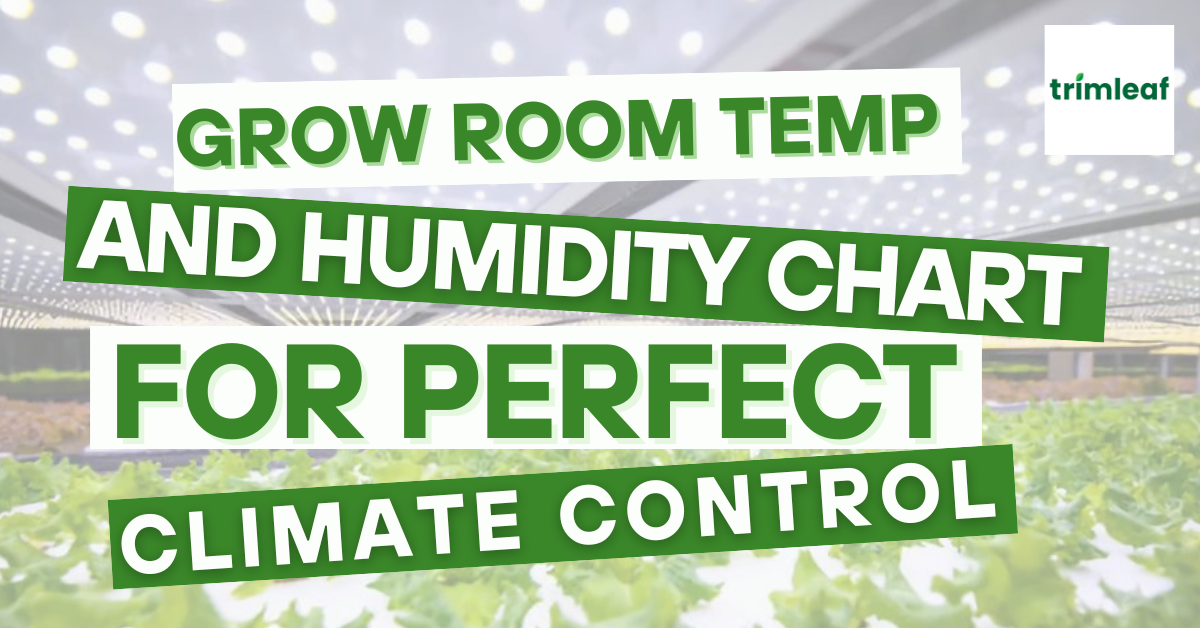
Getting your grow room's temperature and humidity dialed in perfectly can feel like trying to hit a moving target. One day everything's running smooth, the next day you're dealing with droopy plants, mold issues, or stunted growth in your grow tent.
Here's the thing: temperature and humidity aren't just numbers on a gauge, they're factors that determine whether your plants grow and thrive or just survive. Understanding optimal temperature and humidity levels is crucial for any indoor growing operation.
The good news? Once you understand the basics and have the right humidity chart and temperature controls to follow, maintaining perfect environmental conditions becomes second nature. Whether you're managing humidity in your grow tent or controlling temperature in a larger grow room, this guide will help you grow like a pro.
Why Grow Room Temp and Humidity Matters

Think of your grow room like a carefully orchestrated dance between temperature and humidity. Your plants grow best when they can "breathe" properly, taking in water through their roots and releasing it through their leaves in a process called transpiration. This is why humidity in a grow space needs constant monitoring.
When optimal temperature and humidity levels are balanced, your plants grow efficiently. Understanding how to control the temperature and manage humidity levels is essential for any successful indoor grower. If not, you'll notice the following problems:
- Plants stress out, leaves curl, growth slows
- Mold and mildew move in uninvited
- Plants get confused and growth becomes inconsistent
- Stunted development and reduced yields
The secret is matching your environmental conditions to what your plants need at each stage of their life cycle, whether you're growing in a small grow tent or larger indoor space.
Essential Equipment for Climate Control
Temperature Control
- AC Unit: Best for precise cooling in larger spaces and grow rooms
- Space Heater: Ceramic heaters are safest for nighttime warming in your grow
- Exhaust Fans: Remove hot air and create airflow to control temperature
- Grow Light Controllers: Manage heat from LED grow lights effectively
Humidity Control
- Dehumidifier: Absolutely essential to reduce humidity during flowering stage
- Humidifier: Ultrasonic models work great for maintaining higher humidity levels in seedling areas
- Circulation Fans: Keep air moving to prevent hot/humid spots in your grow tent
Monitoring Equipment
- Digital Thermometer/Hygrometer: Get one with min/max memory to track humidity and temperature
- Smart Controllers: Automate your fans and climate equipment for optimal humidity control
- Phone Apps: Monitor remotely and get alerts when humidity in your grow goes off target
The Complete Grow Room Temp and Humidity Chart
Here's your go-to humidity chart and temperature guide for perfect environmental control throughout your grow. These optimal humidity and temperature levels will help your plants grow at their maximum potential:
Seedling Stage (Days 1-21)
High humidity helps tiny roots stay hydrated, while stable temperatures prevent shock during early development. Maintaining these conditions ensures the fastest, healthiest germination and strong seedling growth.
| Time | Temperature | Humidity |
|---|---|---|
| Lights On | 72-77°F (22-25°C) | 65-75% |
| Lights Off | 65-70°F (18-21°C) | 65-75% |
| Sweet Spot | 75°F (24°C) | 70% |
✓ What to Watch: Keep conditions super stable. Seedlings can't handle stress like mature plants. This is when optimal temperature control matters most for healthy plant development.
Vegetative Stage (Weeks 3-8) - Peak Growth Phase
Plants grow rapidly and can handle more variation in temperature and humidity. Cooler nights promote healthy root development, and gradually lowering humidity prepares plants for flowering.
| Time | Temperature | Humidity |
|---|---|---|
| Lights On | 70-85°F (21-29°C) | 55-70% |
| Lights Off | 65-75°F (18-24°C) | 55-70% |
| Sweet Spot | 75-80°F (24-27°C) | 60-65% |
✓ Pro Tip: Gradually lower humidity level as plants get bigger. Their root systems can handle more of the water workload, and you'll want to reduce humidity to prepare for flowering.
Early Flowering (Weeks 1-3 of Flower)
Slightly cooler temperatures trigger flowering hormones, and a bigger day/night temperature difference promotes bud development. Lower humidity reduces mold risk as buds begin to form.
| Time | Temperature | Humidity |
|---|---|---|
| Lights On | 68-80°F (20-27°C) | 45-55% |
| Lights Off | 60-70°F (15-21°C) | 45-55% |
| Sweet Spot | 75°F day, 65°F night | 50% |
⚠️Critical: Start dropping humidity now. Buds are forming and mold risk increases. Learning how to control the temperature and manage humidity in your grow becomes crucial during this transition.
Mid to Late Flowering (Weeks 4-8+) - Bud Development
Lower temperatures concentrate terpenes and cannabinoids, while cool nights boost resin production. Maintaining moderate humidity maximizes potency and prevents mold.
| Time | Temperature | Humidity |
|---|---|---|
| Lights On | 65-75°F (18-24°C) | 40-50% |
| Lights Off | 55-65°F (13-18°C) | 40-50% |
| Sweet Spot | 70°F day, 60°F night | 45% |
Final Flush (Last 1-2 Weeks) - Quality Enhancement
Low humidity forces plants to pump out resin, and cool, dry conditions improve final quality. This stage maximizes trichome production and overall potency.
| Time | Temperature | Humidity |
|---|---|---|
| Lights On | 65-75°F (18-24°C) | 30-40% |
| Lights Off | 55-65°F (13-18°C) | 30-40% |
| Sweet Spot | 68°F day, 58°F night | 35% |
This humidity and temperature chart serves as your complete reference for maintaining optimal conditions throughout the entire grow cycle.
Understanding VPD Chart

VPD (Vapor Pressure Deficit) sounds complicated, but it's simple: it's the relationship between temperature and humidity that tells you how hard your plants are working to move water from their roots to their leaves.
Think of it like this: If relative humidity is too low for your temperature, plants work overtime and get stressed. If humidity levels are too high, plants get lazy and don't absorb nutrients efficiently. Thidentify the optimal rangefind that sweet spot where plants grow most efficiently.
VPD Targets by Stage:
- Seedling: 0.4-0.8 kPa (go easy on baby plants)
- Vegetative: 0.8-1.1 kPa (sweet spot for fast growth)
- Flowering: 1.0-1.5 kPa (push plants for maximum production)
✓ Pro Tip: Use a VPD calculator. Put your grow tent temperature and humidity, and it'll tell you if you're in the optimal zone for your plants to grow.
Most Common Problems in Your Grow Room and How to Fix Them
Get the balance wrong in your grow tent or room? You'll see problems fast:
Problem: Plants Growing Too Slowly
Likely Cause: Temperature too cool or humidity level too high/low for the stage
Quick Fix: Check your humidity chart above and adjust. Plants often perk up within 24 hours of reaching optimal temperature and humidity levels.
Problem: Leaves Curling or "Taco-ing"
Likely Cause: Too hot, too dry, or both - classic signs of poor temperature control
Quick Fix: Increase relative humidity slightly and improve air circulation. Check for grow light heat issues too.
Problem: Mold or Powdery Mildew
Likely Cause: High humidity levels, poor air circulation in your grow tent
Quick Fix: Reduce humidity immediately, increase airflow, and check your exhaust system to control the temperature.
Problem: Nutrient Deficiencies That Won't Fix
Likely Cause: VPD is off, so plants can't uptake nutrients properly
Quick Fix: Get optimal humidity and temperature in the ideal range before adjusting nutrients.
Problem: Slow Bud Development
Likely Cause: Not enough temperature difference between day/night
Quick Fix: Drop nighttime temps by 10-15°F compared to daytime for better temperature in your grow.
Problem: Inconsistent Temp and Humidity
Likely Cause: Poor environmental controls or faulty HVAC/ventilation.
Quick Fix: Regularly inspect and maintain your ventilation, heating, and cooling equipment. Use automated controllers and sensors.
Ideal Grow Tent Temperature Settings

Your grow tent temperature management differs slightly from larger grow rooms due to the enclosed environment:
Your grow tent temperature management differs slightly from larger grow rooms due to the enclosed environment. Smaller spaces tend to heat up faster from grow lights, and humidity can spike quickly without proper ventilation.
As a result, temperature control in a grow tent requires more frequent monitoring. While LED grow lights produce less heat than other lighting options, they still have an impact on your grow tent’s temperature and should be taken into account.
Best Practices for Grow Tent Climate
- Install intake and exhaust fans sized for your tent volume
- Use a small circulation fan to prevent hot spots
- Monitor humidity and temperature at canopy level
- Consider the heat output of your specific grow light setup
Conclusion
Dialing in the perfect temperature and humidity for your grow room might seem daunting at first, but with the right knowledge and a little practice, it quickly becomes second nature. By following the guidelines and charts in this article, you can create an environment where your plants thrive—not just survive—at every stage of their life cycle.
Remember, healthy plants start with a stable environment. Stay proactive with your climate control, monitor your grow tent regularly, and don’t be afraid to adjust as conditions change.
Happy growing!
Frequently Asked Questions About Grow Room Temp and Humidity Chart
- ◄Why are temperature and humidity so important in a grow room?
- Temperature and humidity directly affect plant growth, nutrient uptake, transpiration, and resistance to mold. The right balance leads to vigorous, healthy plants and higher yields.
- ◄What are the ideal temperature and humidity levels for seedlings?
- Seedlings thrive at 72–77°F with 65–75% humidity. These conditions support strong root development and prevent stress during early growth.
- ◄How should I adjust humidity during the vegetative stage?
- During vegetation, aim for 70–85°F with 55–70% humidity. Gradually lower humidity as plants mature to prepare them for flowering.
- ◄What’s the best temperature and humidity for flowering plants?
- In early flowering, maintain 68–80°F with 45–55% humidity. Lower it to 65–75°F and 40–50% humidity in late flower to boost potency and prevent mold.
- ◄What is VPD and why does it matter?
- Vapor Pressure Deficit (VPD) measures how well plants transpire based on temperature and humidity. Balanced VPD promotes optimal nutrient uptake and healthy growth.
- ◄What are common signs of temperature or humidity problems?
- Look for curling leaves (too hot/dry), slow growth (cold or high humidity), or mold (too humid). Check your grow room temp and humidity chart to correct quickly.
- ◄How can I control temperature in my grow tent?
- Use exhaust fans, AC units, or ceramic heaters. Monitor canopy-level temps and adjust grow light height to prevent heat stress.
- ◄What tools do I need to monitor temperature and humidity?
- Invest in a digital thermometer/hygrometer with min/max memory, VPD calculator apps, and optionally smart controllers for automated climate control.
- ◄How much does it cost to set up climate control?
- Expect to spend $200–$500 for a basic setup, $500–$1000 for intermediate automation, and over $1000 for full environmental control in larger grow rooms.
- ◄How do I avoid mold and mildew in my grow room?
- Keep humidity in check, especially during flowering. Use dehumidifiers, maintain airflow, and avoid wild swings in environmental conditions.




